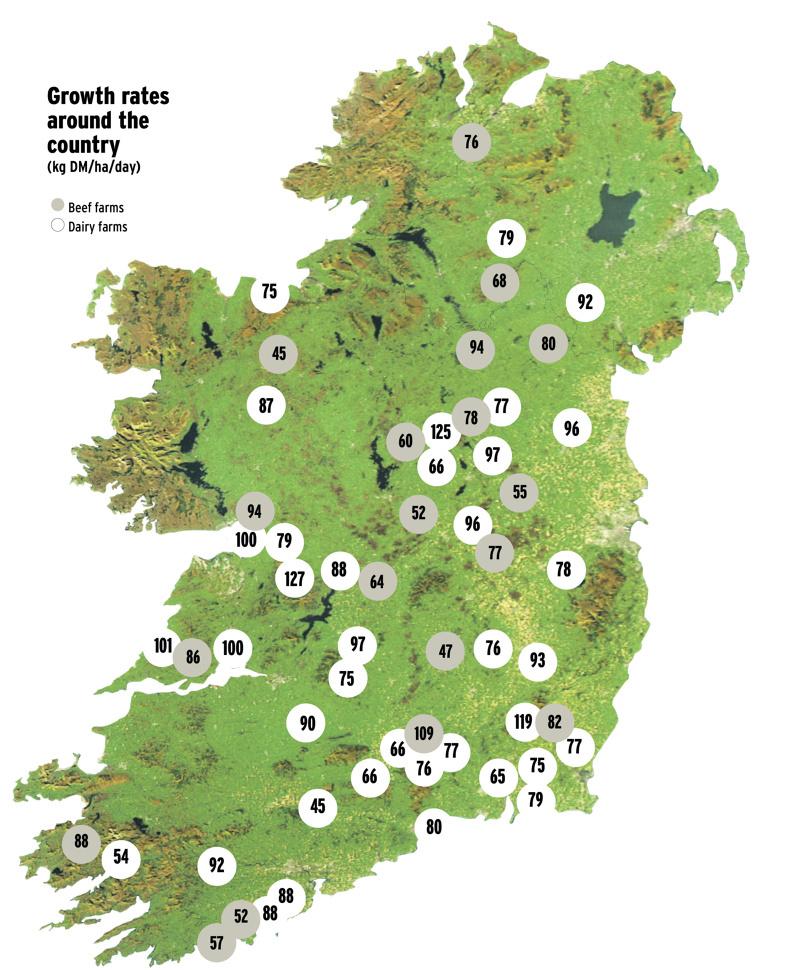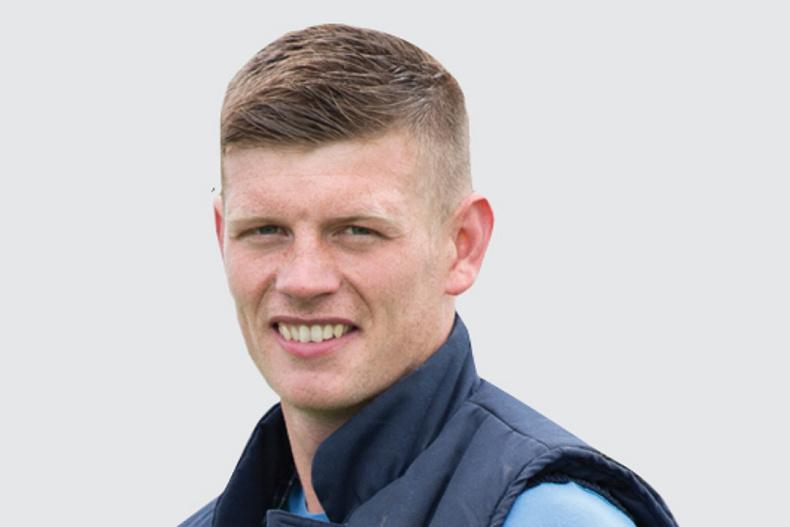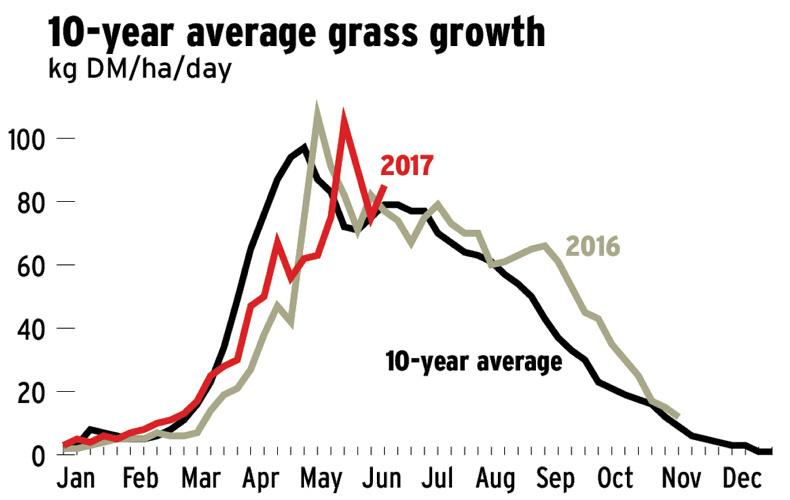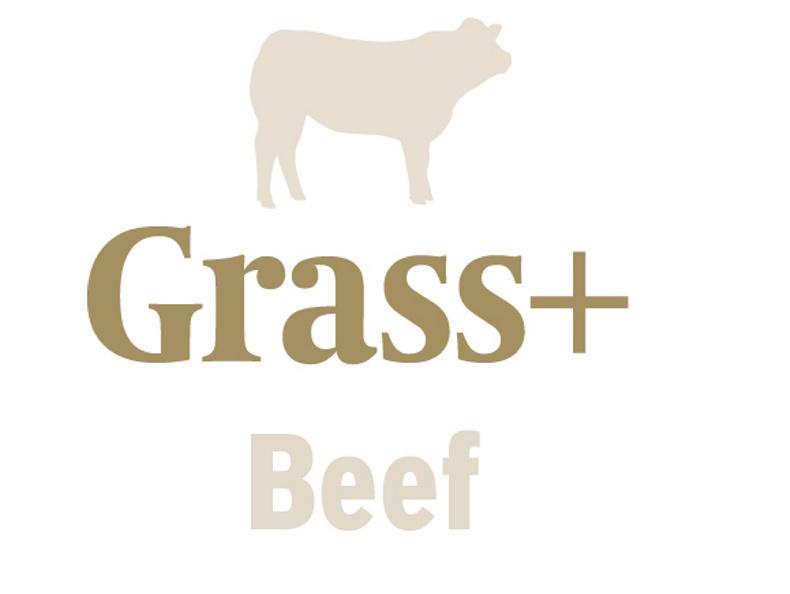Grass growth on the country’s drystock farms has increased slightly on last week to 72kg DM/ha/day.
Indeed, we would expect this figure to climb in the coming days as it encompasses some of the cold, wet days prior to the weekend’s heatwave. The good weather has led to a flurry of field work, with the tail end of first-cut silage completed and surplus paddocks baled up.
If paddocks are closed up, resist the urge to wait for too long to lift. The weather has been kind to us for a number of days now, but looks set to turn again on Sunday for much of the country – next week might be very different from a grass and grazing point of view.
Cut these paddocks now and get them growing again. They will be slower to come back than grazed plots and if ground conditions become difficult, we might need them again sooner than we think.
With most farmers having saved significant amounts of silage at this point, it is a good time to consider how much more is needed, either from second and possibly third cuts, or surplus grazing area.
A suckler cow will need 1.4t (fresh) of 25% dry matter pit silage for each month during the winter. Her spring-born calf will need 0.6t and store cattle will need 1.3t per month.
Assume that poor-, average- or good-yielding first-cut silage will produce seven, eight or nine tonnes per acre, respectively. With second-cut, assume three, four or five tonnes per acre for poor-, average- or good-yielding crops.
However, it’s best to get out and physically measure your silage pit to obtain an accurate handle on what’s saved so far.
Search “silage pit measuring” on our YouTube channel, farmersjournal.tv, for an accurate guide.
For bales, assume a 24-hour wilted bale equates to 0.78t of equivalent pit silage.
On grass, keep measuring and managing. I have no doubt that stem has established itself in the swards of most of the country’s beef farms by now.
If your next paddock is stemmy, bale it up now and mark these bales for dry cows – you might even be able to bale a couple of fields.
Either way, aim to have cattle turning into 8-10cm of leafy grass next regardless – don’t feel that they have to eat this stemmy grass just because it’s there. It has a poorer feed value compared with what your animals should be eating and growth will be well ahead of demand for the coming period.


Co Kerry
System: suckler to weanling
Soil type: variable
Avg farm cover (kg DM/ha): 1,168
Grass growth (kg DM/ha/day): 88
While we did get some heavy rain over the last few weeks, we didn’t have it as bad as parts of the south. We have taken a number of paddocks out as bales and will have to take more out over the next weeks or so. Bales this year are well wilted compared with other years with the good spells of weather. Being in the programme and having a focus on grass is making a big difference to us. I have never seen such a good bunch of calves on the ground as this year and I put this down to the grass quality. Calves will be due their booster for IBR and blackleg soon and will get a worm dose also. I am continuing to reseed paddocks on the outfarm where swards were old. I am spreading 2t of lime/acre to try to boost soil pH. Three bags of 10-10-20 are spread after seeding. I am using a clover-safe post-emergence spray after to beat docks. I find the battle with docks is won at reseeding, not a year later.

Co Leitrim
System: suckler to weanling
Soil type: mostly heavy
Avg farm cover (kg DM/ha): NA
Grass growth (kg DM/ha/day): NA
We’re making the most of the good weather as we’ve managed to save some top-quality hay. I also baled another 4 acres of first cut over the weekend on an outer block of ground. The aftergrass on the silage ground here is doing very well and there’s a nice thick sward coming back. It was cut on 24 May and since then it has received 2,000 gallons of slurry along with three bags of 18-6-12 10 days after the slurry application. I hope to cut the crop in mid-July and I may cut this again later in the year. I have plenty of grass and calves are beginning to kick on. Bull calves are averaging 1.5kg/day, with heifers doing between 1.3kg and 1.4kg/day. Poor-performing paddocks will receive lime in September/October when the grazing season is ending and I begin to close paddocks up for the spring. I’m very happy with the shoring and drainage work I carried out earlier in the year.

Co Cavan
System: suckler to weanling
Soil type: heavy clay
Avg farm cover (kg DM/ha): 766
Grass growth (kg DM/ha/day): 94
Grass growth has been strong in recent weeks and, as a result of the recent spell of good weather, utilisation rates have remained high. The good growth has allowed me to take 45 surplus bales of high-quality grass from paddocks this week. I made my first-cut silage on 23 May and the ground has since got 1,800 gallons of slurry. Last week I sprayed a few paddocks that were heavily infested with docks using Forefront-T and I look to have got a good response. All the stock are doing well at present and this week calves will get a booster vaccine for blackleg. They were given their initial shot five weeks ago. The Charolais stock bull is out with the cows now four weeks, cleaning up any that were missed using AI. He will remain out for another week just in order to keep my calving spread as tight as possible. I hope to scan all cows next week to ensure all cows are in calf.

Derrypatrick Herd, Co Meath
System: suckler to weanling
Soil type: mixed
Avg farm cover (kg DM/ha): 730
Grass growth (kg DM/ha/day): 50
Prior to the recent spell of good weather, broken weather resulted in a number of paddocks not topped and this is evident in paddocks at present with more stem and grass heading out than desired. Fortunately, current grazing conditions are exceptional. Desirable post-grazing heights (4-4.5cm) are being achieved. Each grazing is now being followed with the topper to clean any ungrazed areas. We have clover sown in 21 paddocks out of a targeted 34. In order to establish clover in these paddocks it is a necessity that pre-grazing covers are <1,200kgDM/ha. As these paddocks become our top priority, our grassland management will change and may result in paddocks not destined for clover to be removed as surplus. Grass growth is behind this time last year but rain is forecast and will boost growth. It is vital to remove any surplus areas from the grazing platform.

Read more
Growth surges in heat and sunny weather
Grass growth on the country’s drystock farms has increased slightly on last week to 72kg DM/ha/day.
Indeed, we would expect this figure to climb in the coming days as it encompasses some of the cold, wet days prior to the weekend’s heatwave. The good weather has led to a flurry of field work, with the tail end of first-cut silage completed and surplus paddocks baled up.
If paddocks are closed up, resist the urge to wait for too long to lift. The weather has been kind to us for a number of days now, but looks set to turn again on Sunday for much of the country – next week might be very different from a grass and grazing point of view.
Cut these paddocks now and get them growing again. They will be slower to come back than grazed plots and if ground conditions become difficult, we might need them again sooner than we think.
With most farmers having saved significant amounts of silage at this point, it is a good time to consider how much more is needed, either from second and possibly third cuts, or surplus grazing area.
A suckler cow will need 1.4t (fresh) of 25% dry matter pit silage for each month during the winter. Her spring-born calf will need 0.6t and store cattle will need 1.3t per month.
Assume that poor-, average- or good-yielding first-cut silage will produce seven, eight or nine tonnes per acre, respectively. With second-cut, assume three, four or five tonnes per acre for poor-, average- or good-yielding crops.
However, it’s best to get out and physically measure your silage pit to obtain an accurate handle on what’s saved so far.
Search “silage pit measuring” on our YouTube channel, farmersjournal.tv, for an accurate guide.
For bales, assume a 24-hour wilted bale equates to 0.78t of equivalent pit silage.
On grass, keep measuring and managing. I have no doubt that stem has established itself in the swards of most of the country’s beef farms by now.
If your next paddock is stemmy, bale it up now and mark these bales for dry cows – you might even be able to bale a couple of fields.
Either way, aim to have cattle turning into 8-10cm of leafy grass next regardless – don’t feel that they have to eat this stemmy grass just because it’s there. It has a poorer feed value compared with what your animals should be eating and growth will be well ahead of demand for the coming period.


Co Kerry
System: suckler to weanling
Soil type: variable
Avg farm cover (kg DM/ha): 1,168
Grass growth (kg DM/ha/day): 88
While we did get some heavy rain over the last few weeks, we didn’t have it as bad as parts of the south. We have taken a number of paddocks out as bales and will have to take more out over the next weeks or so. Bales this year are well wilted compared with other years with the good spells of weather. Being in the programme and having a focus on grass is making a big difference to us. I have never seen such a good bunch of calves on the ground as this year and I put this down to the grass quality. Calves will be due their booster for IBR and blackleg soon and will get a worm dose also. I am continuing to reseed paddocks on the outfarm where swards were old. I am spreading 2t of lime/acre to try to boost soil pH. Three bags of 10-10-20 are spread after seeding. I am using a clover-safe post-emergence spray after to beat docks. I find the battle with docks is won at reseeding, not a year later.

Co Leitrim
System: suckler to weanling
Soil type: mostly heavy
Avg farm cover (kg DM/ha): NA
Grass growth (kg DM/ha/day): NA
We’re making the most of the good weather as we’ve managed to save some top-quality hay. I also baled another 4 acres of first cut over the weekend on an outer block of ground. The aftergrass on the silage ground here is doing very well and there’s a nice thick sward coming back. It was cut on 24 May and since then it has received 2,000 gallons of slurry along with three bags of 18-6-12 10 days after the slurry application. I hope to cut the crop in mid-July and I may cut this again later in the year. I have plenty of grass and calves are beginning to kick on. Bull calves are averaging 1.5kg/day, with heifers doing between 1.3kg and 1.4kg/day. Poor-performing paddocks will receive lime in September/October when the grazing season is ending and I begin to close paddocks up for the spring. I’m very happy with the shoring and drainage work I carried out earlier in the year.

Co Cavan
System: suckler to weanling
Soil type: heavy clay
Avg farm cover (kg DM/ha): 766
Grass growth (kg DM/ha/day): 94
Grass growth has been strong in recent weeks and, as a result of the recent spell of good weather, utilisation rates have remained high. The good growth has allowed me to take 45 surplus bales of high-quality grass from paddocks this week. I made my first-cut silage on 23 May and the ground has since got 1,800 gallons of slurry. Last week I sprayed a few paddocks that were heavily infested with docks using Forefront-T and I look to have got a good response. All the stock are doing well at present and this week calves will get a booster vaccine for blackleg. They were given their initial shot five weeks ago. The Charolais stock bull is out with the cows now four weeks, cleaning up any that were missed using AI. He will remain out for another week just in order to keep my calving spread as tight as possible. I hope to scan all cows next week to ensure all cows are in calf.

Derrypatrick Herd, Co Meath
System: suckler to weanling
Soil type: mixed
Avg farm cover (kg DM/ha): 730
Grass growth (kg DM/ha/day): 50
Prior to the recent spell of good weather, broken weather resulted in a number of paddocks not topped and this is evident in paddocks at present with more stem and grass heading out than desired. Fortunately, current grazing conditions are exceptional. Desirable post-grazing heights (4-4.5cm) are being achieved. Each grazing is now being followed with the topper to clean any ungrazed areas. We have clover sown in 21 paddocks out of a targeted 34. In order to establish clover in these paddocks it is a necessity that pre-grazing covers are <1,200kgDM/ha. As these paddocks become our top priority, our grassland management will change and may result in paddocks not destined for clover to be removed as surplus. Grass growth is behind this time last year but rain is forecast and will boost growth. It is vital to remove any surplus areas from the grazing platform.

Read more
Growth surges in heat and sunny weather












 This is a subscriber-only article
This is a subscriber-only article












SHARING OPTIONS: